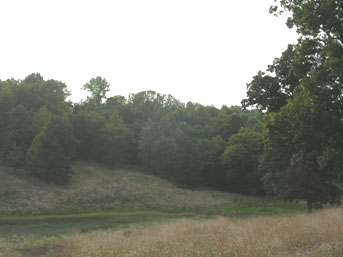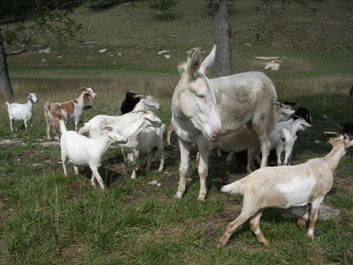Our Range
 Our ranch offers a warm welcome to our caprine residents, including an ample amount of browse (leaved plants, briars, vines, small saplings, etc.). The terrain is heavily laced with lime-stone ridges and outcroppings, sporting a variance in elevations that the goats enjoy. It gives them outlooks for prowlers, such as coyotes, and helps them maintain healthy hooves with scarcely any need for trimming!
Our ranch offers a warm welcome to our caprine residents, including an ample amount of browse (leaved plants, briars, vines, small saplings, etc.). The terrain is heavily laced with lime-stone ridges and outcroppings, sporting a variance in elevations that the goats enjoy. It gives them outlooks for prowlers, such as coyotes, and helps them maintain healthy hooves with scarcely any need for trimming!
When we acquired the ranch, it was evident that a combination of heavy limestone, obviously overworked soil and resulting erosion over the years left the pastures in rather poor circumstances.
 The grass available included ample amounts of Johnson and Fescue. After researching various options, we decided that the vegetation and lay of the land were quite ideal for goats. Further inquiries confirmed that the Kiko species was uniquely adaptable to Middle Tennessee, given their natural strengths and resiliency. By combining rotation of the goats with cultivation and planting (i.e. clover, orchard grass, etc.), we plan to improve our pastures significantly, giving us the option, in the future, to introduce cattle to graze alongside the goats. For now, the naturally occurring springs and our own well (which did not fail us throughout the hot 2007 Summer!) have kept our goats healthy and productive!
The grass available included ample amounts of Johnson and Fescue. After researching various options, we decided that the vegetation and lay of the land were quite ideal for goats. Further inquiries confirmed that the Kiko species was uniquely adaptable to Middle Tennessee, given their natural strengths and resiliency. By combining rotation of the goats with cultivation and planting (i.e. clover, orchard grass, etc.), we plan to improve our pastures significantly, giving us the option, in the future, to introduce cattle to graze alongside the goats. For now, the naturally occurring springs and our own well (which did not fail us throughout the hot 2007 Summer!) have kept our goats healthy and productive!
 As our animals are self-sufficient and free-ranging, they encounter wild game and predators, including a plethora of coyotes and the occasional bobcat. Our guardian animal of choice is the Jenny – or female donkey. Our young donkey has adapted remarkably to her responsibilities as caretaker of the herd! Æsel (Danish for ‘donkey’) keeps the girls safe from predators and is quite self-sustaining in her own right! (She even makes ‘dust bathing areas’ in the various pastures to keep her clean and parasite free!) We can certainly recommend donkeys as the most self-sufficient and reliable guardians (and they also have quite the personalities!).
As our animals are self-sufficient and free-ranging, they encounter wild game and predators, including a plethora of coyotes and the occasional bobcat. Our guardian animal of choice is the Jenny – or female donkey. Our young donkey has adapted remarkably to her responsibilities as caretaker of the herd! Æsel (Danish for ‘donkey’) keeps the girls safe from predators and is quite self-sustaining in her own right! (She even makes ‘dust bathing areas’ in the various pastures to keep her clean and parasite free!) We can certainly recommend donkeys as the most self-sufficient and reliable guardians (and they also have quite the personalities!).
